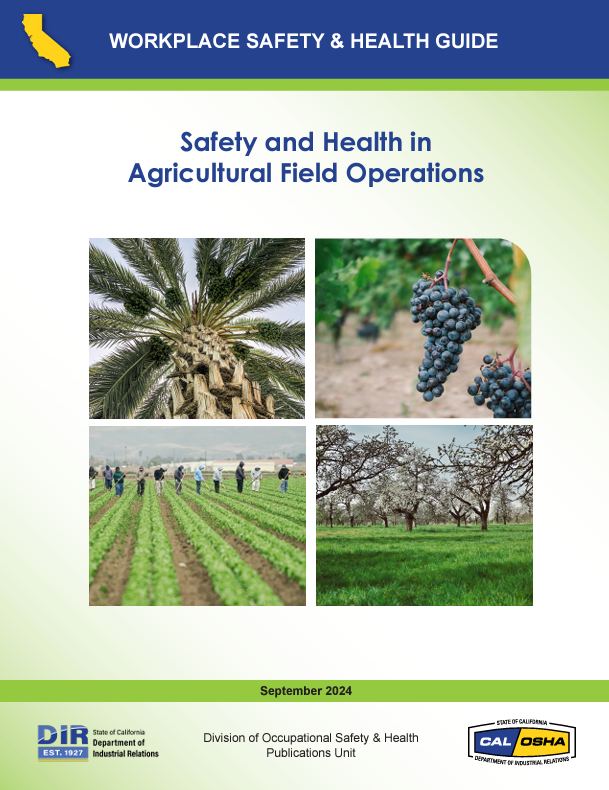Agricultural Field Operations Safety and Health Guide

The "Safety and Health in Agricultural Field Operations" guide is a comprehensive resource developed by Cal/OSHA to help ensure the safety and health of agricultural workers. Here are some key aspects covered in the guide, recently updated September 2024:
Key Topics:
- Machinery Safety
- Guidelines on safely operating tractors, farm machinery, and equipment to prevent accidents.
- Field Sanitation
- Importance of providing toilet, handwashing, and drinking water facilities in the field to maintain hygiene.
- Heat Illness Prevention
- Measures to protect workers from heat-related illnesses, including providing adequate water and shade.
- Musculoskeletal Hazards
- Recommendations for using long-handled tools and preventing prolonged stoop labor to reduce musculoskeletal injuries.
- Skin Protection
- Strategies to prevent skin diseases and injuries from exposure to soil contaminants, fertilizers, and pesticides.
- Electrical Safety
- Guidelines for working safely around high-voltage power lines to prevent electrocution.
- First-Aid and Medical Services
- Information on providing first-aid and medical services in the field.
- Workplace Violence
- Measures to prevent workplace violence and ensure a safe working environment.
- Measures to prevent workplace violence and ensure a safe working environment.
Additional Resources
- The guide also includes information on applicable California Code of Regulations Title 8 (T8CCR) standards, employee training topics, and using a field checklist to ensure compliance with safety regulations.
- Here is a list of training topics available in the Guide:
1. Tractor Safety: Safe operation, maintenance, and emergency procedures.
2. Machinery and Equipment Safety: Proper use and maintenance of farm machinery.
3. Chemical Safety: Safe handling, storage, and disposal of pesticides and fertilizers.
4. Heat Illness Prevention: Measures to protect workers from heat-related illnesses.
5. Ergonomics: Using long-handled tools and preventing musculoskeletal injuries.
6. Field Sanitation: Providing adequate toilet, handwashing, and drinking water facilities.
7. Skin Protection: Preventing skin diseases and injuries from soil contaminants.
8. Electrical Safety: Working safely around high-voltage power lines.
9. First-Aid and Medical Services: Providing first-aid and medical services in the field.
10. Workplace Violence: Preventing workplace violence and ensuring a safe working environment.
11. Confined Spaces: Working safely in confined spaces.
12. Slips, Trips, and Falls: Preventing accidents related to slips, trips, and falls.
13. Noise Control: Protecting workers from noise-induced hearing loss.
14. Respiratory Protection: Using personal protective equipment (PPE) to prevent respiratory issues.
15. Child Safety: Ensuring the safety of young workers on the farm.

Download the latest guide here

